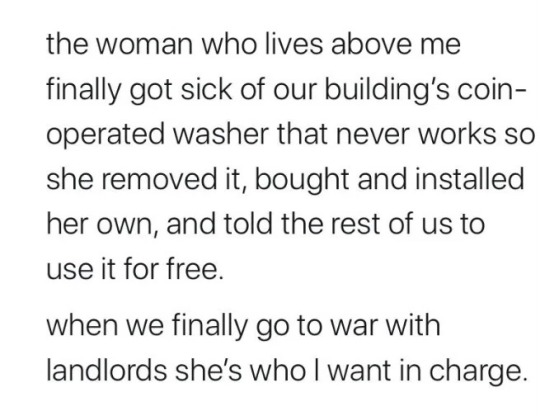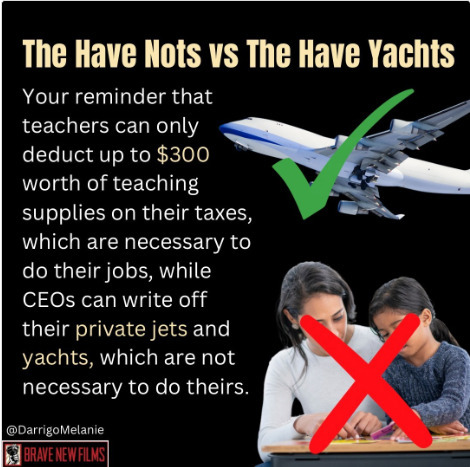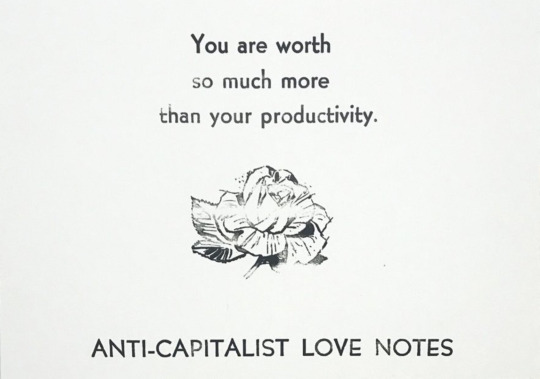#anti capitalist love notes
Text

#communism#anarchism#antifascism#revolution#socialist#anarchy#democratic socialism#socialism#leftist#anti capitalism#marxism#anti capitalists be like#anti capitalist love notes#anti capitalist excellence
3K notes
·
View notes
Text

#working class hero#working class#landlords#landlords are bastards#rent strike#laundry#late stage capitalism#anti capitalism#capitalism#capitalist hell#anti capitalist love notes#writers strike#wga strike#actors strike#sag strike#global strike#workers strike
493 notes
·
View notes
Text

It’s time
2K notes
·
View notes
Text

#anarchism#anarchy#leftist#anti capitalism#antifascism#anticapitalist#antifascist#protest#revolution#communism#socialism#leftism#marxism#marxism leninism#anti imperialism#anti capatilism#anti capitalist love notes#anti capitalists be like#android authority#diamond authority#ownership#struggle#harm#question authority#palestinian authority#time variance authority#liberation#corruption
133 notes
·
View notes
Text
Capitalism goes against human nature
#human rights and civil liberties#capitalism#poverty#classism#fuck capitalism#late stage capitalism#communism#class warfare#poverty is a threat over the working class#violence of poverty#economic violence#anti capitalist love notes#anti imperialism#anti capitalism#revolutionary process#political revolution
22 notes
·
View notes
Text

rax ’italian’ king: so many bosses have told me some variant of ’ it seems as if your only here for the paycheck’ and like. yeah.
rax ’italian’ king: if you stop cutting the checks i stop making to her coffee/running the food/writing your emails for you. what do you think this relationship is
rax ’italian’ king: it’s not enough that you get to watch me waste 40 hours/week off in real time? i have to act like it’s fun to? fuck you
452 notes
·
View notes
Text
The Human Centipede but with billionaires
#politics#anti billionaire#anti capitalism#wealth cap#pro wealth cap#anti capitalist love notes#billionaire#elon musk#anarchy#anarchism#arm the left#arm the people#antifa#antifascist#conservative#liberal#human centipede#the human centipede#bill gates#mark zuckerberg#capitalism#late capitalism#donald trump#trump#second amendment#gun rights
15 notes
·
View notes
Text
Kill capitalism & kill the rich!

#eat the rich#eat the fucking rich#class war#poverty#homeless#anti capitalism#antifascist#antifaschistische aktion#fuck money#antimoney#anticapitalista#anti capitalist love notes#anticapitalistically#kill the rich#antiwork#anti slavery#ausgov#politas#auspol#tasgov#taspol#australia#fuck neoliberals#neoliberal capitalism#anthony albanese#albanese government#wage slavery#slavery#homelessness#capitalism
227 notes
·
View notes
Text

#pro choice#responsibility#purpose#failure#choices#focus#culture#class war#class warfare#anti capitalism#eat the rich#fuck landlords#class struggle#anti capitalist love notes#anti capitalists be like#fuck capitalism#late stage capitalism#capitalism#socialism
2K notes
·
View notes
Text

#wage slavery#stockholm syndrome#late stage capitalism#anti capitalism#anti capitalist love notes#carl marx
65 notes
·
View notes
Photo

source: https://www.radicalemprints.com/
#anti capitalist love notes#parenting#date night#love notes#lovenotes#love language#therapist#therapy#therapists website#anti capitalist#wise words#words of wisdom#cptsd recovery#trevor resources
137 notes
·
View notes
Text
I am generally an anti-violence type of person (unless we're talking about revolution and war against imperialism) but I find so much humor when someone says that communism/socialism doesn't work because it creates violent dictatorships like that isn't the pure description of capitalism.
I mean, just because the violence is hidden from your eyes and your understanding, it doesn't mean it's not there, and just because you have the illusion of control through the con of democracy, it doesn't mean you actually have control over your government.
Apparently, socialism failed after a try period of 30/40 years under heavy capitalist opposition and oppression, but capitalism has been falling for 500 years now and that's okay, like we're not dying by the thousands because of it.
#politics#political discourse#to be honest fuck capitalism#communism#socialism#leftism#left wing#anti capitalism#anti capitalist love notes#fuck the police#fuck the idf#fuck patriarchy#free palestine 🇵🇸#free palestine#free gaza#free west bank#anti colonialism#anti colonization#anti imperialism
11 notes
·
View notes
Text
Atrocities US committed against NATIVE AMERICANS
In 2016, the US army corp of engineers approved a Energy Transfer Partners’ proposal to build an oil pipeline near the Standing Rock Indian Reservation, sparking the Dakota Access Pipeline Protests, evoking a brutal response from North Dakota police aided by the National Guard, private security firms, and other law enforcement agencies from surrounding states. The Standing Rock Sioux tribe believes that the pipeline would put the Missouri River, the water source for the reservation, at risk, pointing out two recent spills, a 2010 pipeline spill into the Kalamazoo River in Michigan, which cost over billion to clean up with significant contamination remaining, and a 2015 Bakken crude oil spill into the Yellowstone River in Montana. Police repression has included dogs attacking protesters, spraying water cannons on protesters in sub-freezing temperatures, >700 arrests of Native Americans and ~200 injuries, a highly militarized police force using armored personnel carriers, concussion grenades, mace, Tasers, batons, rubber bullets, and tear gas. In November 2017, the keystone XL pipeline burst, spilling 210,000 gallons of oil in Amherst, South Dakota.
In 1975, FBI agents attacked AIM activists on the Pine Ridge Reservation, in the ‘Pine Ridge Shootout’. Two FBI agents, and an AIM activist were killed. In two separate trials, the U.S. prosecuted participants in the firefight for the deaths of the agents. AIM members Robert Robideau and Dino Butler were acquitted after asserting that they had acted in self–defense. Leonard Peltier was extradited from Canada and tried separately because of the delay. He was convicted on two counts of first–degree murder for the deaths of the FBI agents and sentenced to two consecutive terms of life in prison, after a trial which is still contentious. He remains in prison.
In 1973, 200 Oglala Lakota and AIM activists occupied the town of Wounded Knee, South Dakota, on the Pine Ridge Reservation, called the Wounded knee incident. They were protesting the reservation’s corrupt US-backed tribal chairman, Dick Wilson, who controlled a private militia, called Guardians of the Oglala Nation (GOONs), funded by the government. FBI, US marshals, and other law enforcement cordoned off the area and attacked the activists with armored vehicles, automatic rifles, machine guns, grenade launchers, and gas shells, resulting in two killed and 13 wounded. Ray Robinson, a civil rights activist who joined the protesters, disappeared during the events and is believed to have been murdered. As food supplies became short, three planes dropped 1,200 pounds of food, but as people scrambled to gather it up, a government helicopter appeared overhead and fired down on them while groundfire came from all sides. After the siege ended in a truce, 120 occupiers were arrested. Wilson stayed in office and in 1974 was re-elected amid charges of intimidation, voter fraud, and other abuses. The rate of violence climbed on the reservation as conflict opened between political factions in the following three years; residents accused Wilson’s private militia of much of it.
In Nov. 1969, a group of 89 Native Americans occupied Alcatraz Island for 15 months, to gauge the US’s commitment to the Treaty of Fort Laramie (1868), which stated that all abandoned federal land must be returned to native people. Eventually the government cut off all electrical power and all telephone service to the island. In June, a fire of disputed origin destroyed numerous buildings on the island. Left without power, fresh water, and in the face of diminishing public support and sympathy, the number of occupiers began to dwindle. On June 11, 1971, a large force of government officers removed the remaining 15 people from the island.
From its creation in 1968, The American Indian Movement (AIM) has been a target of repression from law enforcement agencies, and surveillance as one of the FBI’s COINTELPRO targets. This includes the wounded knee incident and the pine ridge shootout.
In 1942 the federal government took privately held Pine Ridge Indian Reservation land owned by tribal members in order to establish the Badlands Bombing Range of 341,725 acres, evicting 125 families. Among the families evicted was that of Pat Cuny, an Oglala Sioux. He fought in World War II in the Battle of the Bulge after surviving torpedoing of his transport in the English Channel. Dewey Beard, a Miniconjou Sioux survivor of the Wounded Knee Massacre, who supported himself by raising horses on his 908-acre allotment received in 1907 was also evicted. The small federal payments were insufficient to enable such persons to buy new properties. In 1955 the 97-year-old Beard testified of earlier mistreatment at Congressional hearings about this project. He said, for “fifty years I have been kicked around. Today there is a hard winter coming. …I might starve to death.”
In 1890, US soldiers killed 150-300 people (including 65 women and 24 children) at Wounded Knee (19-26 people, including two women and eleven children.) on the Lakota Pine Ridge Indian Reservation in the U.S. state of South Dakota. Twenty-five soldiers also died, and 39 were wounded (6 of the wounded later died). At least twenty soldiers were awarded the Medal of Honor. The event was driven by local racism towards the practice of Ghost Dancing, which whites found distasteful, and the Native Americans arming up in response to repeated broken treaties, stolen land, and their bison-herds being hunted to near extinction by the whites.
In 1887, the Dawes Act, and Curtis Act, resulted in the loss of 90 million acres of native-alloted land, and the abolition of many native governments. During the ensuing decades, the Five Civilized Tribes lost 90 million acres of former communal lands, which were sold to non-Natives. In addition, many individuals, unfamiliar with land ownership, became the target of speculators and criminals, were stuck with allotments that were too small for profitable farming, and lost their household lands. Tribe members also suffered from the breakdown of the social structure of the tribes.
Starting in the 1870s, The US army, aided by settlers and private hunters, began a widespread policy of slaughtering bufallo and bison, in order to destroy many tribe’s primary food source, and to starve Native Americans into submission. By 1900, they succeeded; the bufallo population dropped from more than 30 million, to a few hundred. The country’s highest generals, politicians, and presidents including Ulysses S. Grant, saw the destruction of buffalo as solution to the country’s “Indian Problem.” By destroying the food supply of the plains natives, they could more easily move them onto reservations.
Starting in 1830-50, The Trail of Tears was a series of forced removals of Native American nations, including Chickasaw, Choctaw, Creek, Seminole, Cherokee people and the African freedmen and slaves who lived among them, from their ancestral homelands in the Southeastern United States to an area west of the Mississippi River that had been designated as Native Territory. The forced relocations were carried out by various government authorities following the passage of the Indian Removal Act in 1830. “Marshaled by guards, hustled by agents, harried by contractors,they were being herded on the way to an unknown and unwelcome destination like a flock of sick sheep.” They went on ox wagons, on horses, on foot, then to be ferried across the MississippiRiver. The army was supposed to organize their trek, but it turned over its job to private contractors who charged the government as much as possible, gave the Indians as little as possible. The Cherokee removal in 1838 (the last forced removal east of the Mississippi) was brought on by the discovery of gold near Dahlonega, Georgia in 1828, resulting in the Georgia Gold Rush. Approximately 2,000-6,000 of the 16,543 relocated Cherokee perished along the way.
In 1848, the California Genocide is a term used to describe the drastic decrease in Native American population in California. The population decreased from ~300,000 in 1769, to 16,000 in 1900.
The Second Seminole War, also known as the Florida War, was a conflict from 1835 to 1842 in Florida between various groups of Native Americans collectively known as Seminoles and the United States, part of a series of conflicts called the Seminole Wars. The Second Seminole War, often referred to as the Seminole War, is regarded as “the longest and most costly of the Indian conflicts of the United States.” ~3000 seminoles were killed, and 4000 were deported to Indian territory elsewhere.
In 1832, the Black Hawk War, was a brief 1832 conflict between the United States and Native Americans led by Black Hawk, a Sauk leader, in Illinois. The war gave impetus to the US policy of Indian removal, in which Native American tribes were pressured to sell their lands and move west of the Mississippi River and stay there. Over 500 Native Americans were killed in the conflict.
In 1832, the Chickasaw Indians were forced by the US to sell their country in 1832 and move to Indian Territory (Oklahoma) during the era of Indian Removal in the 1830s.
In 1813, the Creek War, was a war between the US, lead by the then notorious indian-hunter Andrew Jackson, and the Creek nation, residing primarily in Alabama. Over 1,500 creeks were killed. The war effectively ended with the Treaty of Fort Jackson, where General Andrew Jackson insisted that the Creek confederacy cede more than 21 million acres of land from southern Georgia and central Alabama. These lands were taken from allied Creek as well as Red Sticks. In 1814, Andrew Jackson became famous for his role in the Battle of Horseshoe Bend, where his side killed more than 800 Creeks. Under Jackson, and the man he chose to succeed him, Martin Van Buren, 70,000 Indians east of the Mississippi were forced westward.
The Red Sticks, a faction of Muscogee Creek people in the American Southeast, led a resistance movement against European-American encroachment and assimilation; tensions culminated in the outbreak of the Creek War in 1813.
From 1785-96, the Northwest Indian War was a war between the US and a confederation of numerous Native American tribes, with support from the British, for control of the Northwest Territory. President George Washington directed the United States Army to enforce U.S. sovereignty over the territory. Over 1,000 Native Americans were killed in the bloody conflict.
In the 1800s, Indian removal was a policy of the United States government whereby Native Americans were forcibly removed from their ancestral homelands in the eastern United States to lands west of the Mississippi River, thereafter known as Indian Territory. That policy has been characterized by some scholars as part of a long-term genocide of Native Americans.
The Texan-Indian Wars were a series of 19th-century conflicts between settlers in Texas and the Southern Plains Indians. Its hard to approximate the number of deaths from the conflicts, but the Indian population in Texas decreased from 20,000 to 8,000 by 1875.
The Indian Wars is a name given to the collection of over 40 conflicts and wars between Native Americans and US settlers. The US census bureau reports that they have cost the lives of about 19,000 white men, women and children, including those killed in individual combats, and the lives of about 30,000 Indians. The actual number of killed and wounded Indians must be very much higher than the number given… Fifty percent additional would be a safe estimate.
From 1500-1900s, European and later US colonists and authorities displaced and committed genocide on the Native American Population. Ward Churchill characterizes the reduction of the North American Indian population from an estimated 12 million in 1500 to barely 237,000 in 1900 as a “vast genocide.. the most sustained on record.
#anti capitalism#socialism#leftism#anarchy#communism#late stage capitalism#classism#economics#inequality#capitalism#current events#us healthcare#us house of representatives#us history#us hegemony#anti imperialism#imperialism#anti capitalist love notes#tweet#anti capitalists be like#anti capatilism#native american#killers of the flower moon
29 notes
·
View notes
Text
I love that boomers and gen x think tiktok radicalized me into a communist because I can tell you right now the thing that has radicalized me the MOST is working at a business. I see first hand how exploitative and wasteful capitalism is every day of my life. And I have seen the spreadsheets of how much money a worker here produces for the company a quarter (it’s in the millions) and they barely get paid above minimum wage. I know the millions and millions the big guys at the top make in bonuses ALONE while doing a small fraction of the work middle management does. I was told I would get a bonus that was 10% of my salary, and I was so happy because I was gonna use it to make a small dent on my student loans, only for them to say “sorry bad economy :/“ and give me 100 dollars, meanwhile the company profited almost 1 billion dollars last year. You could redistribute a fraction of a fraction of that profit and change the lives of everyone in the company. I see constantly how this business is contributing to the climate crisis tremendously in the name of short term profit for a small few at the top. Living in capitalism radicalized me, not the crochet tutorials I watch on tiktok.
#rant about capitalism#capitalism core#capitalism is evil#deconstruction#leftist#leftism#anti capatilism#anti capitalist love notes#anti capitalist#anti consumerism#socialist
12 notes
·
View notes
Text

rob:
“No-one is forcing you to work at that job you hate”
I think you will find the threat of starvation and homelessness is fairly coercive
121 notes
·
View notes